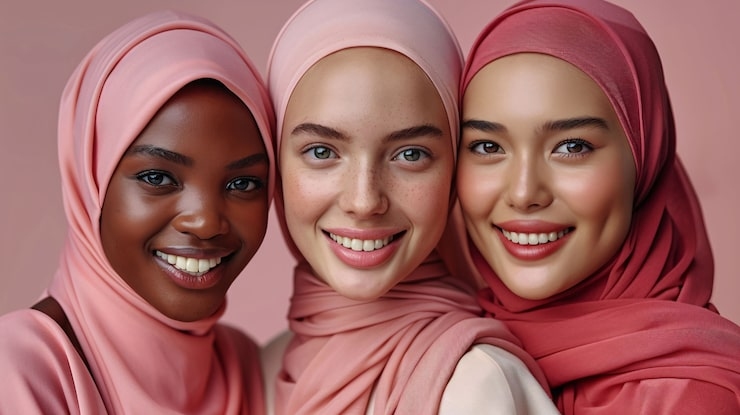Is it appropriate to call a hijab a headscarf? The complexity of religious culture and language.
Views :
Update time : 2024-10-22
Introduction: The meaning behind the words
In today's globalization, the intersection of culture and religion is becoming more and more frequent, and language has become an important bridge between different cultures. With the increase in the Muslim population and the globalization of Islamic culture, the word "Hijab" has become widely known around the world. However, when talking about Hijab, many people tend to simply call it "headscarf". Although this name seems harmless, it hides some linguistic and cultural complexities. This article will explore in depth whether it is appropriate to call Hijab directly "headscarf" and explore the religious, cultural and social impacts.
Differences in the definitions of Hijab and Headscarf
1. The religious connotation of Hijab
In Islamic culture, Hijab is not just a piece of cloth covering the hair, it is a religious obligation that symbolizes the modesty and faith of Muslim women. The wearing of Hijab not only includes covering the head, but may also involve covering other parts of the body. According to the instructions of the Quran, women should cover their bodies to avoid unnecessary eyes. Therefore, Hijab is not only a piece of clothing, but also an expression of faith. It is an important way for Muslim women to maintain modesty and avoid attracting attention in public.
In addition, the meaning of Hijab goes far beyond simply covering the body. It also represents women's self-discipline, inner strength and free choice in faith. For many Muslim women, wearing Hijab is not only a religious obligation, but also a symbol of identity and a public expression of faith.
In addition, the meaning of Hijab goes far beyond simply covering the body. It also represents women's self-discipline, inner strength and free choice in faith. For many Muslim women, wearing Hijab is not only a religious obligation, but also a symbol of identity and a public expression of faith.
2. Broad interpretation of headscarf
In contrast, "headscarf" is a broader term in English, referring to all fabrics used to cover the hair, whether its purpose is for religion, fashion, functionality (such as warmth or sun protection), etc. A headscarf can be a covering of any form, style and function, and is not limited to religious occasions. For example, in Western culture, headscarves can be used as decorative accessories or for warmth in cold weather.
From this perspective, it is obviously a bit one-sided to equate Hijab with headscarf. Headscarf is just a tool to cover hair, but Hijab is a complex religious and cultural symbol, which contains Muslim women's explanation of their beliefs and identities. Therefore, simply equating the two ignores the rich spiritual connotations and cultural background behind Hijab.
From this perspective, it is obviously a bit one-sided to equate Hijab with headscarf. Headscarf is just a tool to cover hair, but Hijab is a complex religious and cultural symbol, which contains Muslim women's explanation of their beliefs and identities. Therefore, simply equating the two ignores the rich spiritual connotations and cultural background behind Hijab.
Cultural and linguistic misunderstandings
1. Simplification and misunderstanding of language
Simply calling Hijab headscarf may lead to misunderstanding and cultural simplification of Muslim women's clothing. Hijab is not only worn to cover hair, but also symbolizes women's observance of religious precepts and their pursuit of inner humility and outer respect. Calling it headscarf may make non-Muslims mistakenly believe that Hijab is just a fashion choice, ignoring its religious meaning and cultural roots.
Behind this simplification of language, it reflects many people's superficial understanding of Islamic culture. When a cultural symbol is simplified to just a tool to "cover hair", people may have a wrong understanding of the actual meaning of this symbol, which in turn affects the understanding and respect of the entire culture and religion.
Behind this simplification of language, it reflects many people's superficial understanding of Islamic culture. When a cultural symbol is simplified to just a tool to "cover hair", people may have a wrong understanding of the actual meaning of this symbol, which in turn affects the understanding and respect of the entire culture and religion.
2. Social Influence and Stereotypes
This confusion of terms may also further exacerbate stereotypes and misunderstandings in society. In Western societies, discussions about Hijab are often sensitive and biased due to the influence of media and political discourse. Some people may view Hijab as a restriction on women's freedom rather than an independent choice of faith. If Hijab is simplified to headscarf, it may further solidify this narrow view and ignore the right of women who wear Hijab to choose their faith.
By respecting the accuracy of language, we can help eliminate these biases and misunderstandings and promote understanding and respect between different cultures.
By respecting the accuracy of language, we can help eliminate these biases and misunderstandings and promote understanding and respect between different cultures.
The necessity of cultural and religious sensitivity
1. Respect for culture
In cross-cultural communication, it is particularly important to respect the original meaning of language and symbols. For Muslim women, Hijab is not just a piece of cloth, but an important part of their faith and identity. Through the correct title, non-Muslims can better understand and respect the deeper meaning of this symbol. Equating Hijab with headscarf may seem to ignore the nuances in Muslim culture and lack cultural sensitivity.
In the context of globalization, more and more people have the opportunity to communicate with people from different cultural and religious backgrounds. Therefore, it is crucial to understand and respect the cultural symbols of others. Especially when it comes to issues related to religion and faith, the precise use of language can help promote harmony and understanding between cultures.
In the context of globalization, more and more people have the opportunity to communicate with people from different cultural and religious backgrounds. Therefore, it is crucial to understand and respect the cultural symbols of others. Especially when it comes to issues related to religion and faith, the precise use of language can help promote harmony and understanding between cultures.
2. Religious freedom and individual expression
Hijab is not only a religious norm, but also a way for many Muslim women to express themselves and show their personal style. In modern society, many women use Hijab of different styles, colors and designs to show their personality while maintaining their loyalty to religion. This self-expression is not limited to the religious category, but has become a manifestation of their identity and faith.
Therefore, understanding the diverse meanings and backgrounds of Hijab can help people understand the multiple identities and choices of Muslim women in modern society. Equating Hijab with headscarf ignores its religious and cultural background, and it is difficult to see how these women balance faith and personality in the era of globalization through this dress.
Therefore, understanding the diverse meanings and backgrounds of Hijab can help people understand the multiple identities and choices of Muslim women in modern society. Equating Hijab with headscarf ignores its religious and cultural background, and it is difficult to see how these women balance faith and personality in the era of globalization through this dress.
Conclusion: Respect and understanding in language
Calling Hijab a headscarf may be a simplified use of language on the surface, but it hides the complexity of cultural, religious and social cognition. Understanding the religious and cultural background of Hijab and respecting its uniqueness will not only help promote cross-cultural understanding, but also help eliminate misunderstandings and stereotypes.
In the context of globalization, we should use language more carefully to ensure accurate understanding and respect for different cultural symbols. This will not only promote understanding between people, but also provide more respect and tolerance for different religious beliefs.
In the context of globalization, we should use language more carefully to ensure accurate understanding and respect for different cultural symbols. This will not only promote understanding between people, but also provide more respect and tolerance for different religious beliefs.




